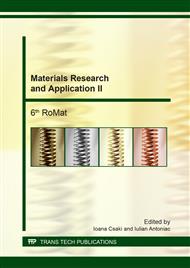[1]
H. So, D. S Yu, C.Y. Chuang, Formation and wear mechanism of tribo-oxides and the regime of oxidational wear of steel, Wear, 253 (9–10) (2002) 1004–1015.
DOI: 10.1016/s0043-1648(02)00230-2
Google Scholar
[2]
W.M. Rainforth, A.J. Leonard, C. Perrin, A. Bedolla-Jacuinde, Y. Wang, H. Jones, Q. Luo, High resolution observations of friction-induced oxide and its interaction with the worn surface, Tribology International, 35 (11) (2002) 731–748.
DOI: 10.1016/s0301-679x(02)00040-3
Google Scholar
[3]
T.F.J. Quinn, Computational methods applied to oxidational wear, Wear, 199 (2) (1996) 169-180.
DOI: 10.1016/0043-1648(95)06856-2
Google Scholar
[4]
M. X. Wei, K. M. Chen, S. Q. Wang , X. H. Cui, Analysis for Wear Behaviors of Oxidative Wear Tribology Letters, 42, (1) (2011) 1–7.
DOI: 10.1007/s11249-010-9741-y
Google Scholar
[5]
I.N. Popescu, M.C. Enescu, V. Bratu, R.I. Zamfir, E.V. Stoian, Advanced Materials Research, Trans Tech Publ. 1114 (2015) 239-244.
Google Scholar
[6]
C. O. Rusanescu, M. Rusanescu; Fl.V. Anghelina, Study of the hot deformability of microalloyed steels using torsion tests, Optoelectron Adv. Mat. Rapid Communications, 7 (11-12) (2013) 947-951.
Google Scholar
[7]
C.O. Rusănescu, M. Rusănescu, The influence of the residual copper on the pipes steel hot plasticity according to environmental requirements, Journal of Mining and Metallurgy B: Metallurgy 49(3) (2013) 353-356.
DOI: 10.2298/jmmb130124036r
Google Scholar
[8]
S. Zamfir, R. Vidu, V. Brînzoi, Coroziunea materialelor metalice, Ed. Did. Ped., Bucureşti, (1994).
Google Scholar
[9]
Vikas, Dr. Nirmal Kant Singh, Manoj Kumar, Cook off study of a 120 mm gun barrel using finite element method, International Journal of Research in Aeronautical and Mechanical Engineering, 3 (1) (2015) 78-87.
Google Scholar
[10]
L. Keresztes, V. Dascalu, http: /www. armyacademy. ro/reviste/3_2000/art17. html, Rev. AFT 3 (2000).
Google Scholar
[11]
L. Keresztes A. Iacobescu, http: /www. actrus. ro/buletin/2_2002/a17. pdf, Bul. AFT 12 (2002).
Google Scholar
[12]
A. Tudor, M. Vlase, Uzarea materialelor, Ed Bren (2010) 294-302.
Google Scholar
[13]
G.W. Stachowiak, A.W. Batchelor, Engineering Tribology, Elsevier, Tribology Series, 24, (1993).
Google Scholar
[14]
I. Crudu, Tribosistem-Tribomodel în studiul sistemelor mecanice, Galaţi University Press, (2008).
Google Scholar
[15]
T. FJ. Quinn, W.O. Winner, The thermal aspects of oxidation wear, Wear 102, (1985).
Google Scholar
[16]
I. Dobrescu, Fenomene de suprafaţă la metale şi aliaje, Ed Academiei Române Bucureşti, (1970).
Google Scholar
[17]
D. Pavelescu, M. Muşat, A. Tudor, Tribologie, Editura Didactică şi Pedagogică Bucureşti, (1977).
Google Scholar
[18]
I. Petre, Research regarding the corrosion wear of the couplings with sliding motion, The annals of Valahia University Târgovişte, 2005, 39-44.
Google Scholar


